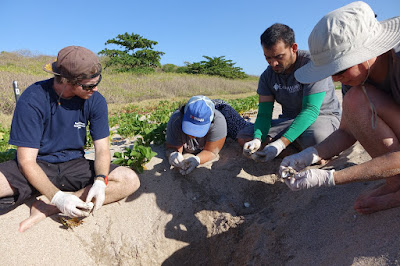Yesterday afternoon we went to the beach to excavate a 70-day old leatherback nest. Normally, turtles incubate for about 60 days before they hatch. The nests will then be dug up to gather data, and any remaining turtles who haven't reached the surface will be released. In the case of this nest, there was no sign of hatchlings on the due date so after waiting 10 days, the biologists decided to excavate.
Biologist Brett walked us down to marker 10 and easily found the
nest, marked by a small pile of upright sticks. The first step was to clear off
the dry sand to prevent a collapse after we started working down in the egg chamber.
We then started digging, looking for the first sign of eggs. When the first egg is spotted, we stop digging to measure the depth.

Then it was time to collect. Brett and I removed the eggs, putting them up onto the sand. It wasn’t as easy as it sounds – leatherbacks are huge animals, and the nest was close to 3 feet deep. Brett had longer arms (and more experience!) than I, so I had to fight to not fall into the nest and crush all the now-rotten eggs. When we got everything out, we re-measured the depth to find out the depth of the original egg chamber (76 cm - about 2.5 feet down).
 |
| Measuring the depth of the topmost eggs: 61 cm |
We then started digging, looking for the first sign of eggs. When the first egg is spotted, we stop digging to measure the depth.

Then it was time to collect. Brett and I removed the eggs, putting them up onto the sand. It wasn’t as easy as it sounds – leatherbacks are huge animals, and the nest was close to 3 feet deep. Brett had longer arms (and more experience!) than I, so I had to fight to not fall into the nest and crush all the now-rotten eggs. When we got everything out, we re-measured the depth to find out the depth of the original egg chamber (76 cm - about 2.5 feet down).
 |
| I almost fell in!! |
Thank goodness for Justine!!
 After measuring the final depth of the chamber, the eggs were
sorted by Milixza and Alan, who pulled out all the SAGs. SAGs are shelled
albumen globes, unviable eggs that are filled with egg whites but have no
embryo. A few are the size of the regular eggs, but most are much smaller -
some as small as grapes. We threw those back into the egg chamber and counted
the remaining eggs. Of those, one had actually hatched, and we needed to
stage the remaining eggs.
After measuring the final depth of the chamber, the eggs were
sorted by Milixza and Alan, who pulled out all the SAGs. SAGs are shelled
albumen globes, unviable eggs that are filled with egg whites but have no
embryo. A few are the size of the regular eggs, but most are much smaller -
some as small as grapes. We threw those back into the egg chamber and counted
the remaining eggs. Of those, one had actually hatched, and we needed to
stage the remaining eggs.
One egg had pipped, meaning the hatchling was fully developed and had started breaking out of its shell but didn't make it. For
the rest, we opened the egg by pinching the shell between our fingernails and
tearing it open much like you’d open a potato chip bag. One by one, Brett,
Mili, Alan and I opened the eggs to find out what stage development the embryo
had reached while Justine recorded all the data in the logbook. The first few eggs I opened were completely mushy
inside (one was even crawling with maggots), and Brett had to carefully sift through
the rotting goo in an attempt to find an embryo. If we couldn’t tell what it was, it
was considered “unknown”.
 |
| Getting our chance to stage eggs |
 |
| A Stage 3 |
Because so many of the eggs had gotten fairly far in their
development, Brett speculates that one possible reason for their demise was the temperature was
too high – this area of Costa Rica is suffering from a major drought,
exacerbated by the El Niño. This season, the leatherback nests on the beach have not been doing well - in general around 50% of leatherback nests are successful, but this year the number is way lower - around 15-20%.
Anyone who doesn't think climate change is a thing, come down and visit the sea turtles...
Anyone who doesn't think climate change is a thing, come down and visit the sea turtles...




Heartbreaking! But still jealous of your experience...
ReplyDeleteIncredible experience. But yet another harsh reminder of life's disadvantages of having T-Rex arms.
ReplyDeleteWow, when I was there in 2009 the percentage of successful hatchlings was way, way higher. Curse you, Global Warming!!
ReplyDeleteThat was me, Kevin. Kathy, I'm sure you realize that I have no idea how to select a profile that'll say my name!
ReplyDelete